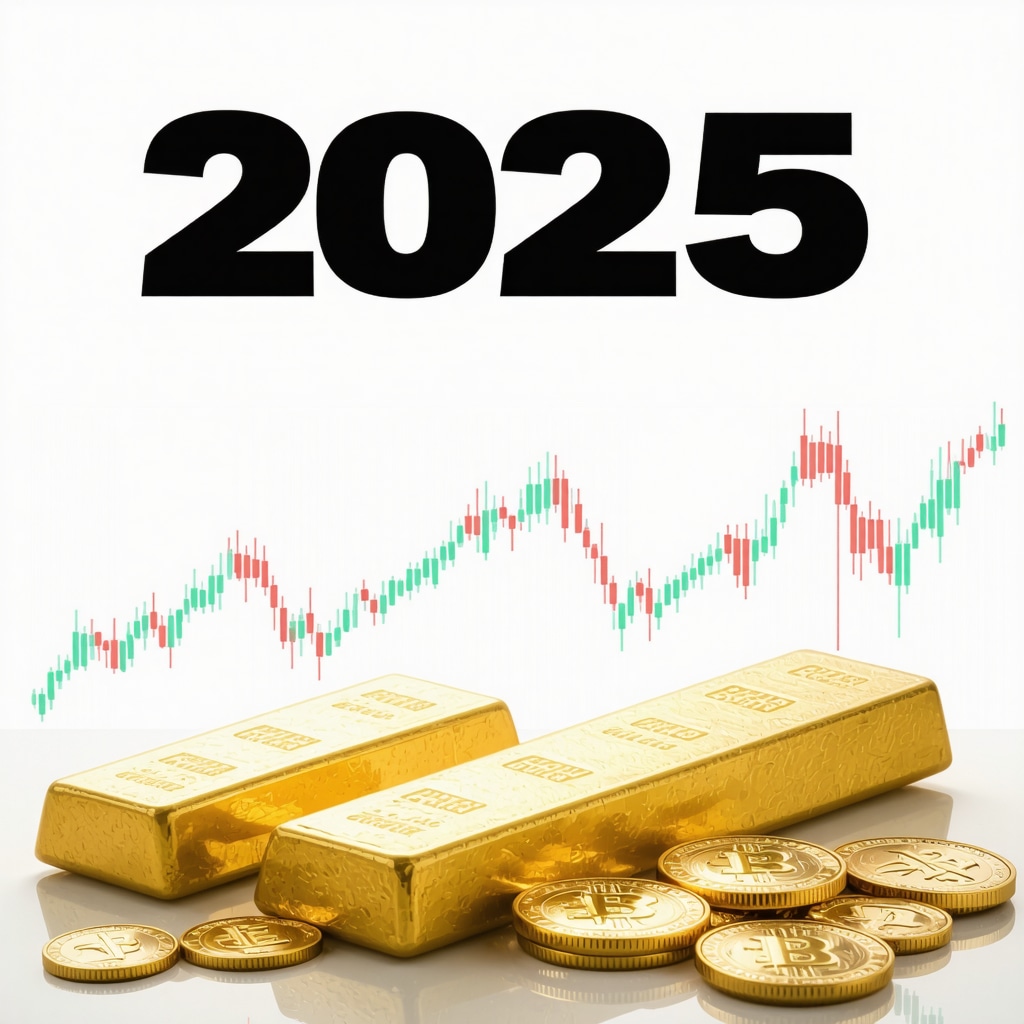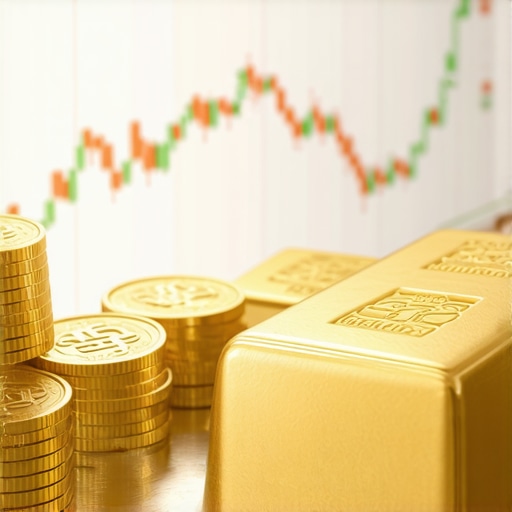Strategic Overview of Gold as a 2025 Investment Asset
In 2025, gold continues to assert its position as a pivotal asset in diversified investment portfolios. Its role transcends mere commodity status, functioning as a hedge against inflation, currency devaluation, and geopolitical risks. Advanced investors recognize that understanding the nuanced types of gold investments is essential to optimizing risk-adjusted returns in a fluctuating global market.
Decoding the Spectrum of Gold Investment Vehicles
Physical Gold: Bars, Coins, and Their Intricate Valuation Dynamics
Physical gold remains the foundation of tangible wealth preservation. Investors must navigate complexities such as purity standards, storage security, and liquidity constraints. The differential premiums on bars versus coins, driven by minting, collectibility, and market demand, require astute market analysis. For authoritative guidance on acquiring physical gold securely, explore how to buy gold bars safely.
Gold Mining Stocks: Leveraging Production Exposure Amid Market Volatility
Investing in gold mining equities offers leverage to underlying gold prices but introduces operational and geopolitical risks. Evaluating mine productivity, cost structures, and management quality is paramount. Mining stocks can exhibit amplified returns compared to bullion but require sophisticated risk management techniques. For actionable insights, consider the risks and rewards of gold mining stocks.
Gold ETFs and Mutual Funds: Balancing Accessibility and Market Efficiency
Exchange-Traded Funds (ETFs) and mutual funds provide liquid, low-cost exposure to gold without physical custody challenges. Investors benefit from portfolio diversification and ease of trading, yet must scrutinize fund management fees and tracking errors. Strategic selection of gold ETFs tailored for 2025 can enhance portfolio resilience, as detailed in choosing the right gold ETF for long-term growth.
How Do Emerging Gold Investment Products Challenge Traditional Paradigms?
New financial instruments such as digital gold tokens and gold-backed cryptocurrencies are disrupting traditional investment frameworks. These products offer fractional ownership and enhanced liquidity but raise concerns regarding regulatory oversight, custody safety, and market manipulation. Experts debate their viability as reliable gold substitutes within a diversified portfolio, reflecting a dynamic evolution in gold investment strategies.
Integrating Gold Demand Trends and Market Drivers in Investment Decisions
Macro factors such as central bank gold acquisitions, inflation trajectories, and geopolitical tensions crucially influence gold’s price dynamics. Analyzing global demand patterns, including shifts in Asian markets and technological applications, informs sophisticated allocation strategies. For an in-depth examination, see the comprehensive global gold demand trends analysis.
Gold’s multifaceted investment forms require an expert-level understanding to harness its full portfolio benefits. For professionals seeking advanced strategies, exploring related expert content and contributing insights to ongoing discourse strengthens market acumen and investment outcomes.
Discover more on advanced gold investment techniques and market analysis by visiting our detailed resources and joining the expert community discussions.
According to the World Gold Council’s 2024 report, gold demand diversification and evolving investor preferences are reshaping market structures, underscoring the importance of a nuanced approach to gold investments (World Gold Council, 2024).
Leveraging Gold Derivatives for Sophisticated Portfolio Management
Beyond traditional gold investment vehicles, advanced investors increasingly utilize gold derivatives such as futures, options, and swaps to enhance portfolio flexibility and hedge risks. These instruments allow for precise exposure adjustments and speculative opportunities without the need for physical ownership. However, derivatives demand deep market understanding due to their complexity and leverage effects, which can amplify both gains and losses.
Institutional investors often deploy gold futures to hedge against anticipated price fluctuations or inflationary pressures. Options strategies, including protective puts or covered calls, provide tailored risk management solutions that align with specific investment objectives. Moreover, gold swaps can optimize liquidity and financing costs in sophisticated trading environments.
Integrating derivatives into a gold investment strategy requires rigorous risk controls and continuous market monitoring to exploit favorable price movements while mitigating downside exposure effectively.
What Are the Emerging Analytical Tools Shaping Gold Market Forecasting in 2025?
With the gold market’s increasing complexity, innovative analytical methodologies have become essential for accurate price forecasting and strategic asset allocation. Quantitative models employing machine learning and artificial intelligence analyze vast datasets encompassing macroeconomic indicators, geopolitical developments, and market sentiment to predict gold price trajectories with improved precision.
Sentiment analysis derived from social media trends and news feeds supplements traditional fundamental analysis, providing real-time insights into investor psychology and potential market inflection points. Additionally, blockchain technology facilitates enhanced transparency in gold supply chains, enabling more trustworthy assessments of physical gold availability and demand.
These cutting-edge tools represent a paradigm shift in gold market intelligence, empowering investors to anticipate volatility and identify lucrative entry or exit points with greater confidence.
Gold’s Role Amidst Evolving Global Economic Policies and Environmental Considerations
Central bank policies, fiscal stimulus measures, and international trade tensions continuously reshape the gold investment landscape. In 2025, the increasing emphasis on environmental, social, and governance (ESG) criteria also affects gold mining operations and investor preferences.
Mining companies adopting sustainable practices and transparent reporting often enjoy enhanced investor trust and potentially superior valuation multiples. Conversely, operations with poor ESG compliance face regulatory risks and reputational challenges, impacting their stock performance.
Therefore, discerning investors prioritize ESG-compliant gold assets, aligning financial returns with ethical considerations and long-term value creation.
For actionable insights on sustainable gold investment options, explore risks and rewards of gold mining stocks that incorporate ESG factors.
According to a detailed analysis by the International Finance Corporation, ESG integration in gold mining significantly influences capital flows and corporate governance standards in 2025 (IFC, 2025).
We encourage readers to share their perspectives on integrating ESG considerations in gold investments and to explore our comprehensive gold ETF strategies for diversified growth in 2025.
Harnessing Gold Derivatives: Precision Tools for Dynamic Market Engagement
In the landscape of 2025 gold investing, derivatives have evolved beyond mere hedging instruments to become essential components of a sophisticated portfolio strategy. Futures, options, and swaps enable investors to tailor exposure with surgical precision, balancing risk and opportunity amid volatile market conditions. For instance, deploying a calendar spread in gold futures can capitalize on expected changes in the term structure of gold prices, while complex option strategies like butterfly spreads or collars allow nuanced positioning around anticipated market events.
However, these instruments require advanced comprehension of leverage dynamics and margin requirements. Misjudging volatility or directional moves can amplify losses disproportionately. Therefore, integrating derivatives demands not only quantitative acumen but also robust risk management frameworks that include scenario analysis and stress testing.
How Can Portfolio Managers Optimize Gold Derivative Strategies to Mitigate Systemic Risk?
Systemic risk, particularly in interconnected financial markets, poses a significant challenge when employing gold derivatives. Portfolio managers are increasingly leveraging multi-factor models that incorporate macroeconomic indicators, cross-asset correlations, and liquidity measures to calibrate derivative positions effectively. Dynamic hedging techniques, such as delta-gamma hedging in options, are utilized to adjust exposures in real time as market conditions evolve.
Moreover, integrating gold derivatives with other asset classes through strategic overlays can reduce portfolio volatility without sacrificing returns. For example, pairing gold futures with inflation-linked bonds offers a complementary hedge against unexpected inflation spikes while maintaining liquidity.
These advanced methodologies underscore the necessity of continuous market monitoring and adaptive strategy refinement, ensuring that derivative use aligns with overarching investment goals and risk tolerance.
Decoding ESG Integration in Gold Mining: Beyond Compliance to Value Creation
With growing investor emphasis on Environmental, Social, and Governance (ESG) factors, gold mining companies are transitioning from compliance-driven frameworks to proactive value creation models. This shift encompasses innovative approaches such as adopting renewable energy sources to power mining operations, implementing water stewardship programs in arid mining regions, and enhancing community engagement through equitable benefit-sharing.
From a valuation perspective, ESG-compliant miners often demonstrate superior operational efficiency and reduced cost of capital, reflecting investor confidence in their sustainable business practices. Advanced analytics enable investors to quantify ESG scores dynamically, correlating these metrics with financial performance and risk-adjusted returns.
Critically, third-party ESG certifications and transparent reporting frameworks, such as the Global Reporting Initiative (GRI) standards, provide validation and comparability across mining enterprises. This transparency mitigates regulatory risks and reputational damage, factors that increasingly influence institutional investor allocations.
For in-depth methodologies and case studies on ESG-driven gold mining investments, the International Finance Corporation’s 2025 report offers comprehensive insights (IFC, 2025).
Advanced Technological Innovations Revolutionizing Gold Supply Chain Transparency
The integration of blockchain technology and Internet of Things (IoT) sensors in the gold supply chain marks a transformative development in 2025. These technologies facilitate immutable tracking of gold provenance from mine to market, enhancing transparency and reducing risks related to fraud, conflict minerals, and illicit trade.
Blockchain-enabled smart contracts automate compliance verification processes and streamline transactions, reducing operational inefficiencies. Simultaneously, IoT sensors monitor environmental parameters and logistical conditions in real time, providing granular data that supports sustainable mining practices and ethical sourcing claims.
Institutions adopting these technologies benefit from enhanced due diligence capabilities, fostering greater trust among stakeholders and aligning with stringent regulatory frameworks globally. This digital transformation not only strengthens supply chain integrity but also adds a new dimension to gold’s investment appeal by embedding verifiable ESG credentials directly into the asset’s lifecycle.

What Are the Challenges and Opportunities of Implementing Blockchain in Gold Investment Portfolios?
While blockchain offers unparalleled transparency, challenges remain around interoperability of platforms, data privacy, and the initial capital outlay for infrastructure integration. Investors must balance these hurdles against the long-term benefits of enhanced traceability and reduced counterparty risk.
Strategically, portfolios incorporating blockchain-verified gold assets may command premium valuations, reflecting decreased uncertainty and improved market confidence. Collaborative initiatives among industry stakeholders are accelerating standardization efforts, which will likely mitigate current challenges and unlock broader adoption.
For investors aiming to stay at the forefront of gold market innovation, understanding these technological dynamics is crucial. Engaging with expert analyses and participating in industry forums can provide invaluable perspectives and strategic advantages.
Explore our advanced resources and join the community dialogue to deepen your expertise in leveraging cutting-edge technologies and ESG frameworks within gold investment strategies.
Innovations at the Intersection of Gold and Cutting-Edge Technologies
The year 2025 marks a pivotal evolution in gold investment paradigms, fueled by the integration of blockchain, IoT, and advanced data analytics. These technologies not only elevate supply chain transparency but also augment investor confidence by embedding immutable provenance records and enhancing ESG compliance tracking. The fusion of these innovations propels gold beyond its traditional role, positioning it as a digitally verifiable asset class aligned with sustainability and governance excellence.
How Can Blockchain Integration Transform Gold Portfolio Risk Management and Valuation Accuracy?
Blockchain’s decentralized ledger systems offer unparalleled granularity and security in tracking gold ownership and movement, significantly mitigating counterparty and fraud risks. This enhanced transparency facilitates precise valuation by enabling real-time verification of asset authenticity and environmental compliance credentials, which are increasingly vital to institutional investors prioritizing ESG factors. However, challenges such as platform interoperability, data privacy concerns, and initial infrastructure investments remain critical considerations. Navigating these requires sophisticated technological partnerships and strategic foresight to harness blockchain’s full potential in portfolio risk mitigation and asset differentiation.
Advanced ESG Metrics: Quantifying Sustainability Impact Within Gold Mining Investments
Contemporary ESG integration transcends basic compliance, incorporating dynamic analytics that quantify environmental impact, social responsibility, and governance quality within gold mining operations. Investors leverage machine learning models to correlate ESG scores with operational performance and long-term financial resilience, thereby identifying companies exhibiting sustainable competitive advantages. Such granular analysis supports capital allocation decisions that align with both fiduciary duties and ethical imperatives, reinforcing the strategic value of ESG-aware gold investments.
Leveraging Sophisticated Derivative Structures for Enhanced Portfolio Resilience
In-depth mastery of gold derivatives—futures, options, and swaps—enables portfolio managers to architect bespoke hedging and speculative strategies tailored to multifactor market conditions. Techniques such as delta-gamma hedging and calendar spreads afford nuanced exposure calibration, mitigating systemic risks amid volatile macroeconomic environments. Integrating these tools with cross-asset overlays, including inflation-linked securities, further refines risk-return profiles, presenting a comprehensive approach to capital preservation and growth.
Authoritative Insights from the International Finance Corporation (IFC) on ESG in Gold Mining
According to the IFC’s 2025 report, ESG integration in gold mining is a critical determinant of capital flows and operational excellence. Their research underscores how sustainable mining practices, transparent governance, and community engagement not only reduce regulatory risks but also enhance investor trust and valuation multiples, reinforcing the imperatives for advanced ESG-aligned investment strategies.
Engage with our advanced gold investment resources to deepen your expertise on integrating blockchain innovations, ESG analytics, and derivative sophistication into your portfolio strategy. Join the expert community dialogue to remain at the forefront of evolving market dynamics.
Expert Insights & Advanced Considerations
Blockchain as a Catalyst for Trust and Valuation Precision in Gold Investments
The integration of blockchain technology is redefining gold investment paradigms by offering immutable provenance tracking and enhanced transparency. This innovation not only mitigates counterparty risks but also provides investors with real-time verification of authenticity and ESG compliance, thereby refining valuation accuracy and elevating confidence among institutional stakeholders.
Advanced Derivative Strategies Elevate Portfolio Resilience Amid Market Volatility
Utilizing sophisticated gold derivatives—such as delta-gamma hedging, calendar spreads, and option collars—enables portfolio managers to tailor risk exposure dynamically in response to multifactor economic indicators. These strategies, when combined with cross-asset overlays like inflation-linked bonds, enhance capital preservation and growth potential even during turbulent market cycles.
ESG Integration Transforms Gold Mining from Compliance to Competitive Advantage
Environmental, Social, and Governance factors have transcended regulatory compliance to become pivotal drivers of operational efficiency and investor appeal in gold mining. Companies pioneering renewable energy use, water stewardship, and community engagement demonstrate superior governance and reduced costs of capital, positioning themselves as preferred investments in an increasingly values-driven market.
Data-Driven Analytics and AI Sharpen Gold Market Forecasting Accuracy
Cutting-edge analytical tools leveraging machine learning and sentiment analysis synthesize complex datasets encompassing geopolitical events, macroeconomic trends, and market sentiment. These models enhance predictive accuracy of gold price movements, empowering investors to identify optimal entry and exit points with greater strategic confidence.
Curated Expert Resources
World Gold Council – Gold Demand Trends 2024: An authoritative source detailing evolving global gold demand patterns and investor behavior, essential for understanding market dynamics (World Gold Council, 2024).
International Finance Corporation – ESG in Mining 2025: Comprehensive research on ESG integration’s impact on capital flows and operational excellence within gold mining enterprises (IFC, 2025).
Buying Gold Now – How to Choose the Right Gold ETF for Long-Term Growth 2025: In-depth guidance on selecting ETFs optimized for resilience and growth in the evolving 2025 market (Buying Gold Now).
Buying Gold Now – Analyzing Global Gold Demand Trends to Predict Price Movements: Expert analysis of macroeconomic and geopolitical drivers shaping gold price trajectories (Buying Gold Now).
Buying Gold Now – Gold Mining Stocks: Risks and Rewards for Smart Investors: Strategic insights into evaluating mining equities with ESG considerations for enhanced portfolio performance (Buying Gold Now).
Final Expert Perspective
The landscape of gold investment in 2025 is characterized by an unprecedented fusion of technology, sustainability, and strategic financial instruments. By embracing blockchain innovations, integrating ESG metrics with rigorous analytics, and deploying sophisticated derivatives, investors can unlock nuanced risk management and valuation advantages. These advanced approaches are not mere trends but essential evolutions that redefine gold’s role as a resilient, ethically aligned, and digitally verifiable asset class. To refine your investment acumen, consider exploring our expert-level resources and join the ongoing dialogue shaping the future of gold investments through gold ETF strategies and market trend analyses.











This comprehensive guide on gold investments in 2025 offers valuable insights into the evolving landscape, especially with regard to emerging technologies like blockchain and AI-driven analytics. Personally, I’ve been exploring the integration of blockchain for supply chain transparency, and I believe it could significantly reduce fraud risks and bolster investor confidence. One challenge I see is the interoperability of different blockchain platforms, which might hinder widespread adoption. Have others found effective strategies to navigate this issue? Overall, staying informed about these innovations seems crucial for making well-rounded investment decisions this year.